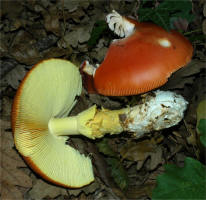
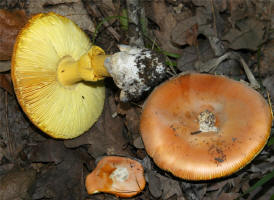
Amanita cesarea (Coastal forest, under Quercus cerris)
Bulgarian Fungi: Summer 2006 (July 15-August 5, 2006)
Amanita


Amanita cesarea (Coastal forest, under Quercus
cerris)
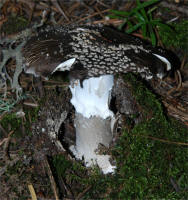 Amanita excelsa var.
spissa (=A. spissa) (Pirin Mtn. 1700 m
Picea abies forest) The distinct striations on the upper annulus make
this a beautiful species. Too bad that we couldn't find more and better
specimens. Looking at the literature, in some cases A. excelsa is listed
as a variety of A. spissa.
Amanita excelsa var.
spissa (=A. spissa) (Pirin Mtn. 1700 m
Picea abies forest) The distinct striations on the upper annulus make
this a beautiful species. Too bad that we couldn't find more and better
specimens. Looking at the literature, in some cases A. excelsa is listed
as a variety of A. spissa.
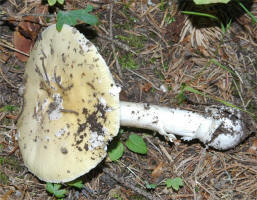
Amanita gemmata/junquillea (Pirin
Mtn. 1800 m Picea abies forests) Indistinguishable from the California
specimens.
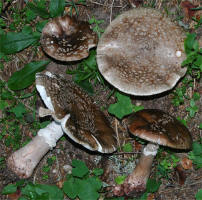
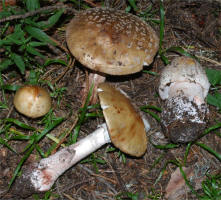
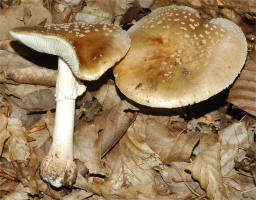
Amanita rubescens The most common species
overall -- found on every walk -- from the high mountain conifer forests to the
coastal hardwood forests.
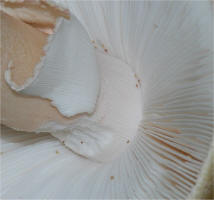
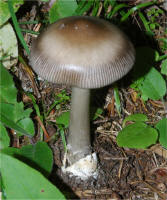
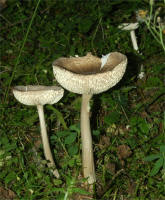
Amanita umbrinolutea (~A. battarae)
(Pirin Mtn. 1700 m Picea abies forest)
Spores: globose 11-13 (14)μ. The
key to the cluster of similarly looking species (+ A. submembranacea)
centers around the abundance of sphaerocysts in the veil...
Amanita lividopallescens (Pirin Mtn. 1800 m. Under Picea abies) Comments: At first sight I thought this to be a Volvariella, until I noticed the striate cap. A walkthrough of the European Vaginatae suggests the above name. The habitat and spore size/shape (9-12 µ globose) rules out A. nivalis, A. mairei, A. argentea and other macroscopically similar (and more interesting) whitish specimens.
Boletus & Allies
Boletus aestivalis (=B. reticulatus) (Saranzi, 700
m, Quercus petrea) Distinguishing the young fruitbodies in the B. edulis
group is more a matter of habitat. On looks alone it could easily be young B.
aereus or B. edulis. Microscopically they are quite similar.
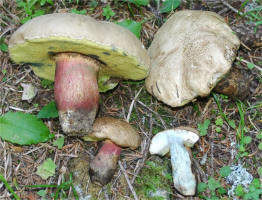
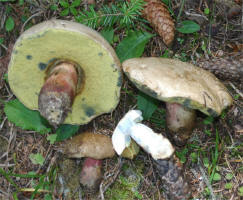
Boletus calopus (Pirin Mtn. 1800 m.
Under Picea abies) What is described
from California as B. calopus var. fructosus
_small.jpg) looks nothing like the European B. calopus. In fact what we call
B. rubripes
looks nothing like the European B. calopus. In fact what we call
B. rubripes
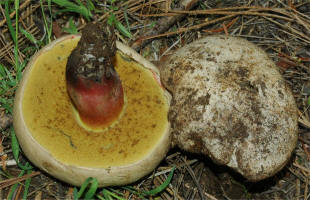 (in California) seems almost identical macroscopically and to the palate to the
European B. calopus.
(in California) seems almost identical macroscopically and to the palate to the
European B. calopus.
On MykoWeb: http://www.mykoweb.com/CAF/species/Boletus_rubripes.html & http://www.mykoweb.com/CAF/species/Boletus_calopus.html
Boletus luteocupreus
(Black Sea coastal forest under Quercus cerris)
Very close to B. rhodopurpureus, but with a yellower cap. Same habitat.
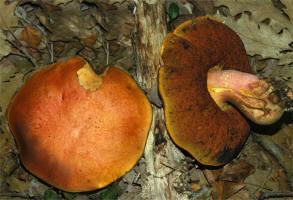
Boletus queletii
(Black Sea coastal forest under Quercus cerris)
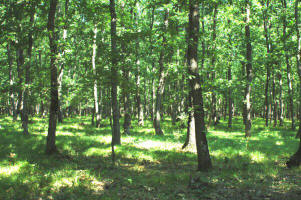
Boletus rhodopurpureus
(Black Sea coastal forest under Quercus cerris)
Boletus rubrosanguineus (Pirin
Mtn. 1600 m. Under Picea abies)
Rare. Very similar to Boletus legaliae (= B. splendidus),
but under Picea abies. According to the The Bulgarian Boletologist Boris.
Assyov, this is a first report and the sporocarp was preserved.
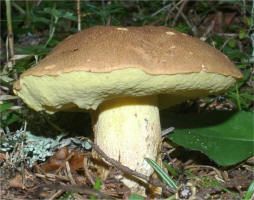
_small.jpg)
_small.jpg)
Boletus subappendiculatus
(Pirin Mtn. 1800 m. Under Picea abies) This
is the Picea variation of B. appendiculatus. Less reddish on the
cap, but the same buttery taste.
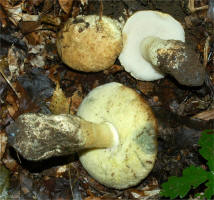
Gyroporus cyanescens
(Vitosha Mtn. 1100 m. Betula pendula and Fagus sylvatica grove)
_small.jpg)
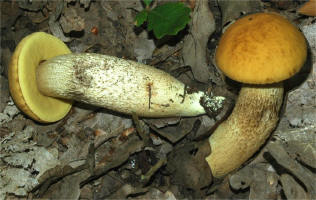
Leccinum crocipodium (=Boletus tesselatus)
(Black Sea coastal forest under Quercus cerris)
_small1.jpg)
_small.jpg)
Porphyrellus porphyrosporus (=Tylopilus pseudoscaber)
(Pirin Mtn. 1800 m. Under Picea abies) Looks identical
macroscopically to the California variation.
Suillus granulatus Of course,
could there be a walk without finding some of these.
Xerocomus cisalpinus (Black Sea
coastal forest. Quercus cerris, Carpinus, and Fagus) The slightly smaller spores
(10-12.5 x 5 - 6μ) and hardwoods habitat distinguish this brethren of X. chrysenteron.
Lactarius
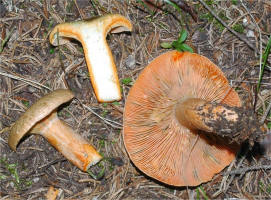
Lactarius deterrimus (Pirin Mtn.
1800 m. Under Picea abies)
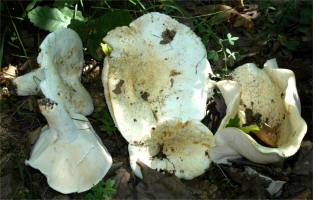
Lactarius piperatus The most
abundant mushroom by far in oak forests.
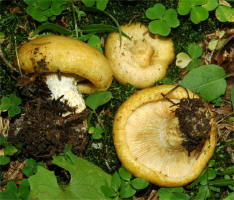
Lactarius scrobiculatus (Pirin
Mtn. 1800 m. Under Picea abies)
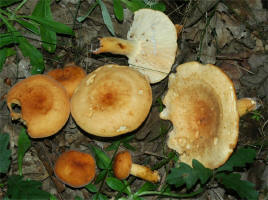
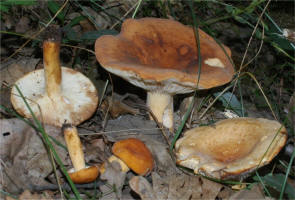
Lactarius volemus
(Saranzi, 700 m, under
Quercus petrea)
Russula
Russula acrifolia
(Saranzi, 700 m, under Quercus petrea) Trying to sort through the blackening Russulas is a morbid experience.
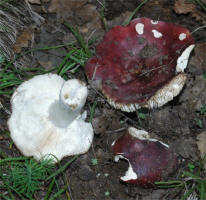
Russula atropurpurea (=R. krombholtzii)
(Saranzi, 700 m, under Quercus spp.)
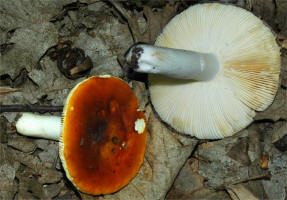
Russula aurea (Black Sea
coastal forest. Quercus , Fagus, Carpinus)
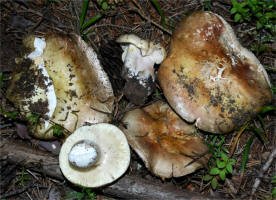
Russula carpini (Pirin Mtn.
1500 m. Mixed Carpinus & others)
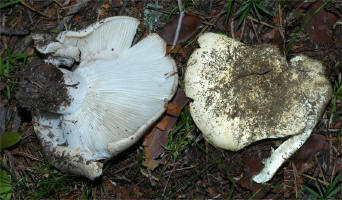
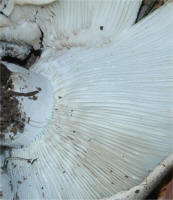
Russula chloroides (Pirin Mtn.
1300 m. Mixed Fagus sylvatica and Picea abies) The same greenish
tinge on the gills as the local Russula brevipes var. acrior
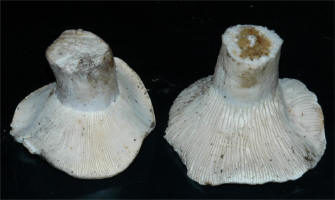 .
The European version tastes somewhat more acrid.
.
The European version tastes somewhat more acrid.
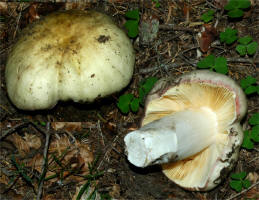
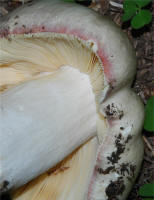
Russula curtipes (Pirin Mtn. 1600 m. Mixed
Betula pendula and Picea abies)
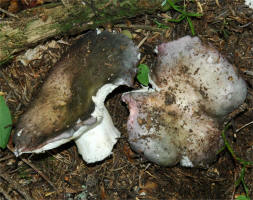
Russula cyanoxantha (Pirin Mtn.
1300 m. Mixed Fagus sylvatica and Picea abies
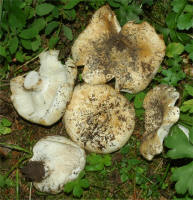
Russula delica (Pirin Mtn. 1300
m. Mixed forest of Fagus sylvatica and Picea abies)
Russula densifolia (Pirin Mtn.
1700 m. Picea abies) Another morbid Compactae.
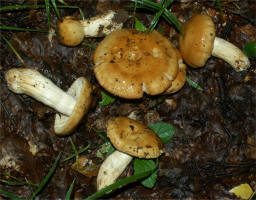
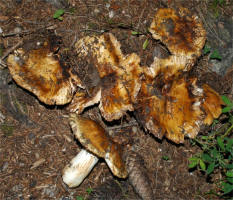
Russula foetens var. foetens & subfoetens
(several locatons, under broadleaves and
conifers) Macroscopically similar to R.
fragrantissima (locally, Nor. Cal).
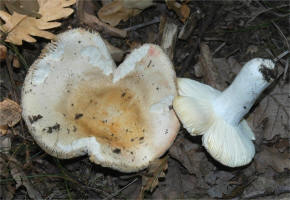
Russula galochroa
(Black Sea coastal forest, Quercus cerris) Only the Italian sources
address the existence of this species. Listed as especially fond of Q. cerris.
Two other Mediterranean Russulas, recently named by Sarnari, come close:
R. prinophila. and R. roseoaurantia.
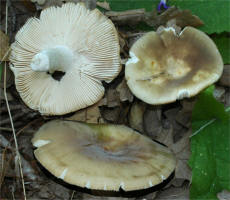
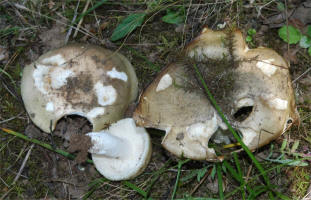
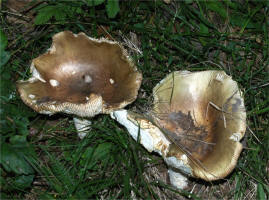
Russula heterophylla (under
Oak -- Quercus cerris and Q. petrea)
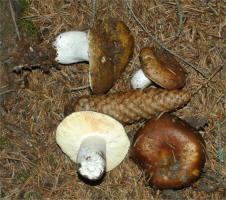
Russula integra
(Pirin Mtn. 1800 m. Under Picea abies & Pinus
peuce)
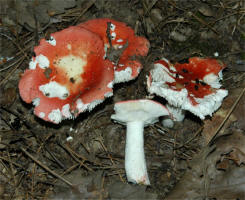
_small.jpg)
_small.jpg)
Russula lepida (= Russula
rosacea)
(Saranzi, 700 m, mixed Quercus petrea/Pinus nigra)
_small.jpg)
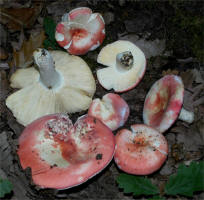
Russula mairei
(several locations, broadleaved forests) Similar to
R. emetica v. sylvestris, but the habitat and spore size/ornamentation
differ significantly. Odor: like a medicine of some kind. Taste: acrid
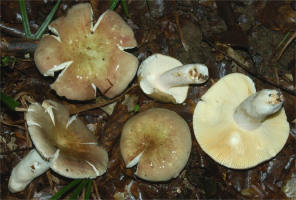
Russula olivacea (Vitosha
Mtn. 1000 m Fagus sylvatica & Quercus spp.) Other than determining it's
edibility right away, it took an extra effort to ascertain if this one really is
R. olivacea or something else. R. curtipes seems similarly
colored, but has no pink on the stipe at all. This olivacea looks
different than the California species.
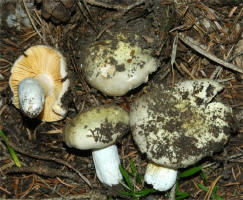
Russula postiana (=R. olivascens)
(Pirin Mtn. 1800 m. Under Picea abies & Pinus
peuce) This id required the "full works". Mentioned as rare.
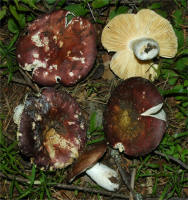
Russula romellii
(Pirin Mtn. 1800 m. Under Picea abies & Fagus
sylvatica)
Russula subterfurcata
(Saranzi, 700 m, under Quercus petrea) This
drab Russula was the first one I found on this trip and in some quantity
at that particular location. Later, it turned out much harder to identify and
listed as less than common. Taste: mild. FeSO4: pinkish. Spores, small: ~ 7 x
6 µ
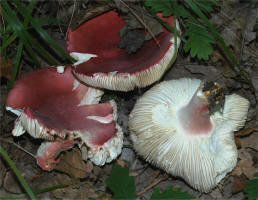
Russula
torulosa
(=R. fuscorubra) (under Quercus petrea)
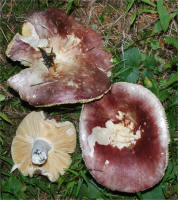
Russula vinosa
(Pirin Mtn. 1800 m. Under Picea abies)
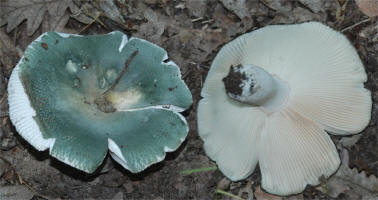
Russula virescens (abundant, several
locations, under both conifers and broadleaves) Green pileus and pinkish gills -- one of my
favorites..
Russula sp.
(Pirin Mtn. 1800 m. Under Picea abies & Fagus
sylvatica) Lost the material for this beautiful specimen. My first reaction
was to call it R. juniperina, similarly yellowing warm weather
Quercus lover. But the montane habitat where I found it doesn't match at
all. The same applies for R. aurea. Another more likely
possibility is a variation of R. rubroalba, in the sense of
Russulales News:
http://www.mtsn.tn.it/russulales-news/tx_photos.asp?index=6159
All Others
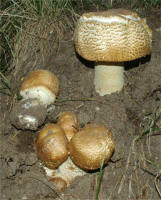
Agaricus augustus (Pirin Mtn. 1800 m
Picea abies forests) Externally no different
than the stout species we find in Northern California.

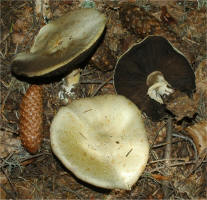
Agaricus sylvicola
(Pirin Mtn. 1800 m
Picea abies & Fagus sylvatica)
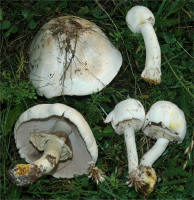
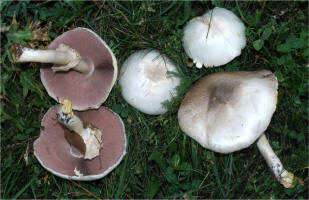
Agaricus xanthodermus (Saranzi,
700 m, an open field)
Went to the same spots I used to collect as a kid in order to finally
identify exactly what type of Agaricus we were gathering. Instead, the California curse followed me --
the first and only Agaricus I found at that location were the yellow-stainers. I
was convinced that they do not grow there because I have no recollection of ever
collecting them as a kid. I had stated many times that A. xanthodermus is
not common in Bulgaria. Do I regret having made that statement... A local shepherd blamed it all
on Chernobyl, saying that the harvest of good Agaricus has declined rapidly since. I
know for a fact that's not the case because last year I found a plethora of
good champignons. A simpler explanation is that they simply weren't fruiting on
the day I came. Well, another time. At least now I know that the yellow stainers
are fruiting in my ancestral picking grounds quite well.
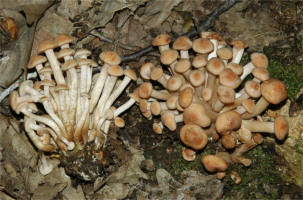
Armillaria tabescens
(Black Sea coastal forest. An old burn) Irene Anderson set this id
straight after some Hebeloma inclinations...
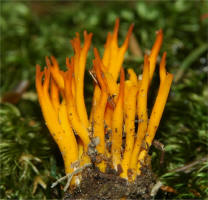
Calocera viscosa
(Pirin Mtn. 1800 m. Under Picea abies)
Cantharellus cibarius (several locations/habitats)
I was told that this was an epic year in the collection of Chanterelles in
Bulgaria. The price went down to approx. $2/lbs.
Clitocybe gibba
(Vitosha Mtn. 1300 m. Under Picea abies)
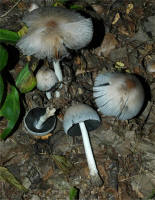
Coprinus cinereus (Black Sea
coastal forest. Quercus , Fagus, Carpinus)
Fomitopsis pinicola Looks like it...
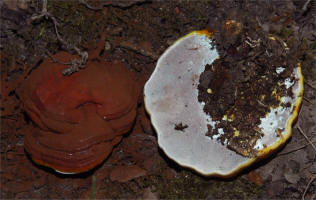
Ganoderma carnosum
(probably) (Pirin Mtn. 1800 m. Under Picea abies)
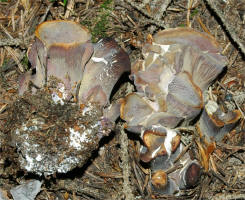
Gomphus clavatus
(Pirin Mtn. 1800 m. Under Picea abies)
This one is in the "Red Book" of threatened species, locally.
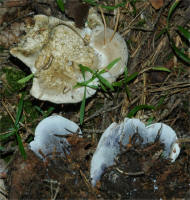
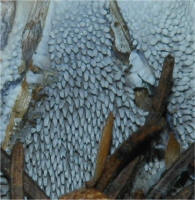
Hydnellum suaveolens
(Pirin Mtn. 1800 m. Under Picea abies)
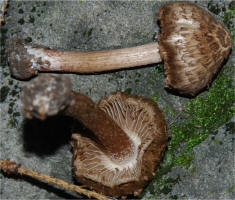
Inocybe cervicolor
(Pirin Mtn. 1800 m. Under Picea abies)
Spores: 10-13 x 6-7.5μ The absence of of apical crystals on the
cystidia sets it apart from most of its id competitors in the Cervicolores
group. Identifying Inocybe in Europe is fun, compared to the local
exercise of cutting through thick fog.
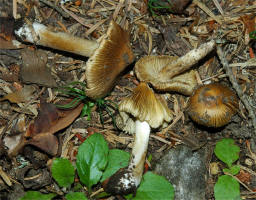
Inocybe rimosa
(Pirin Mtn. 1800 m. Under Picea abies & Pinus
peuce) Odor: spermatic
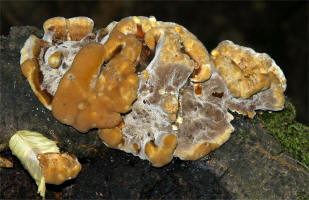
Inonotus dryadeus
(Black Sea
coastal forest. Quercus cerris, Carpinus, and Fagus)
Superficially looks like it, but didn't take material with me to study.
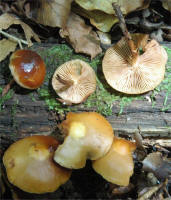
Kuehneromyces (Pholiota)
mutabilis (or lignicola) (Vitosha
Mtn. 1000 m) The spore size is similar. Have the dried sporocarps to analyze
when I'm bored (hopefully not soon).
Lepista irina
(Pirin Mtn. 1800 m. Under Picea abies & Pinus
peuce) Odor: aromatic. The clustered habit threw my id attempts off
(initially) towards Lyophyllum.
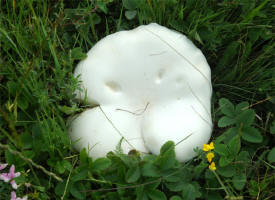
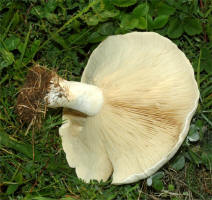
Leucopaxillus
lepistoides
(Saranzi, 700 m, an open field)
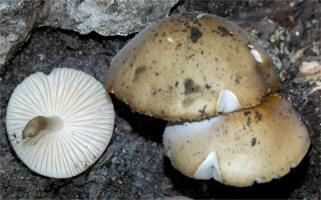
Lyophyllum macrosporum (Varna, burn
area in a tourist destination) I think this might be the right id. I wish some
tourist had stepped on it or my son hadn't seen it. It was a stretch to
identify. The species has giant spores: 15-20
x 10-13 µ (inamyloid ). I couldn't find anything in my references, particularly
amongst the burn loving species that matches. After some research on the
Internet around Fayodia and Lyophyllum, I noticed that there's
such thing as L. macrosporum. The one picture I saw looks similar.
Macrolepiota rachodes
(Pirin Mtn. 1800 m. Under Picea abies & Pinus
peuce) Can't say which variation: rachodes or
brunnea.
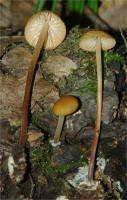 Marasmius cohaerens
(Saranzi, 700 m, Quercus petrea forest)`
Marasmius cohaerens
(Saranzi, 700 m, Quercus petrea forest)`
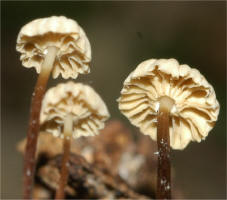
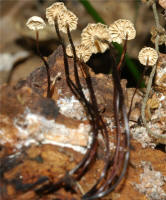
Marasmius rotula
(Saranzi, 700 m, Quercus petrea forest)
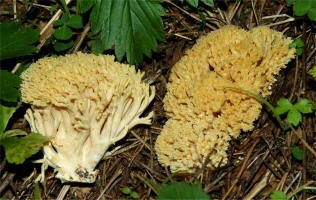
Ramaria flava
(Pirin Mtn. 1800 m. Picea abies
forest)
Ramaria obtusissima
(Pirin Mtn. 1800 m. Picea abies forest. Taste
bitterish.
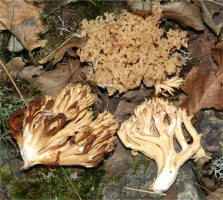
Ramaria sp.
(Saranzi, 700 m, Quercus petrea & Pinus nigra
mixed forest)
Xerula radicata (=Oudemansiella radicata)
(Vitosha Mtn. 1100 m. Under Betula pendula
& Fagus sylvatica)
Defining References:
| "Fungi Europaei" Vol 1: Agaricus | A. Capelli |
| "Fungi Europaei" Vol 2: Boletus | J. Muñoz |
| "Fungi Europaei" Vol 8: Xerocomus | H. Ladurner & G. Simonini |
| "Fungi Europaei" Vol 9: Amaniteae | P. Neville & S. Poumarat |
| "Fungi Europaei" Vol 10: Polyporaceae | A. Bernicchia |
| "Fungi of Switzerland" Vols. 1-6 | Breitenbach & Kraenzlin |
| "I Boletti" | R. Galli |
| "Gli Agaricus" | R. Galli |
| "Le Amanite" | R. Galli |
| "Le Russule" | R. Galli |
| Monografia del genere Russula Vols 1-2 | M. Sarnari |
| Russulales News | http://www.mtsn.tn.it/russulales-news/ |
Special thanks to my friend Boris Assyov
from the Bulgarian Mycological Society for his Boletales
expertise and general advice on the local flora.